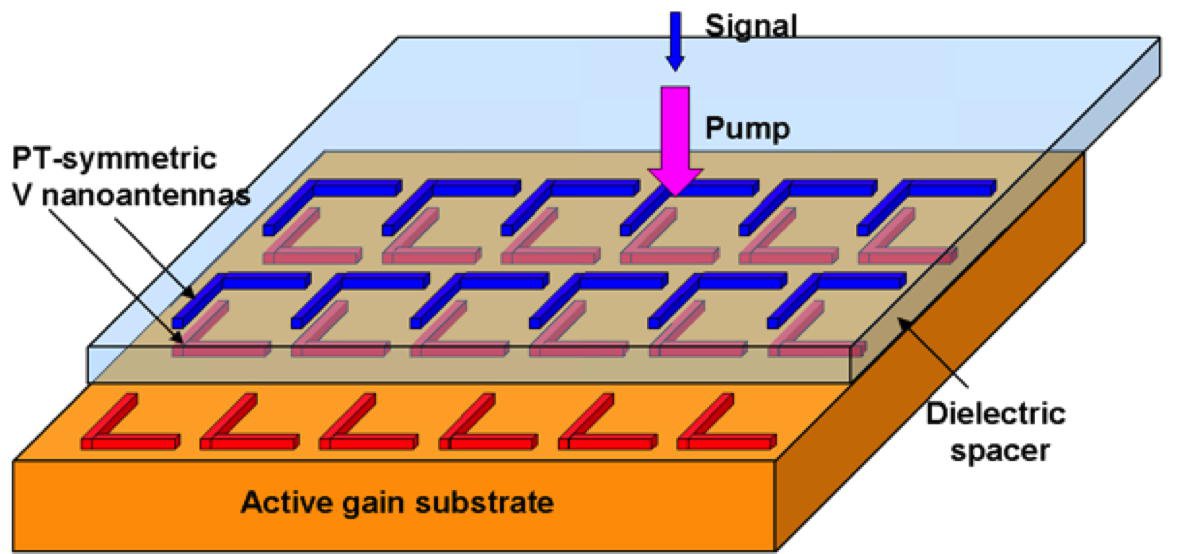Active Functional devices based on Parity-Time optics
The progress of nanotechnologies has triggered the emergence of many photonic artificial structures: photonic crystals, metamaterials, plasmonic resonators. Recently the intriguing class of PT-symmetric devices – referring to Parity-Time symmetry [1],– has attracted much attention. The distinctive feature of PTSS is that the refractive index profile of the structures is complex-valued due to the gain and/or loss, which are spatially separated in the system. These particular spatial repartitions can either occur in the direction transverse to the light propagation direction, as in the case of the coupled directional coupler shown in Fig. 1(a), or in the longitudinal direction, as in the case of the PT-symmetric Bragg grating waveguide (PTSBG) represented in Fig. 1(b). Beside academic motivations, our interest to these artificial systems is strongly driven by the practical outcomes detailed below.

1. Unidirectional single mode DFB laser exploiting the concept of PT-symmetry
The sketch of the unidirectional DFB laser is shown in Fig. 2a. The PT-symmetric Bragg grating is achieved through the technological realization combining a metallic Bragg grating insuring modulation of the imaginary part of the complex index profile with that of a quarter period shifted dielectric Bragg grating modulating the real part of the index profile [Figs. 2(b,c)]. Due to the narrow-band amplified “unidirectional” reflection of PTSBG introducing additional gain discrimination mechanism, it is expected that the coherence of such a laser would be highly tolerant with respect to the optical feedback, i.e. to reflections along the optical path. This is one of the worst network impairment issues, currently addressed by means of abutted garnet-based optical isolators, which are very costly, not least because of the positioning and mounting efforts in a module. A clearly desirable alternative would be isolator-free laser packages if the puzzle of lasers highly tolerant to optical feedback could be solved. Ongoing theoretical and experimental collaborative activity in the framework of ANR project PARTISYMO between C2N, LCF and III-V Lab along this line is in progress.

2. Electro-optical spatial switch
In such a PTSS the effective detuning of the propagation constants between the odd and even supermodes (i.e., propagation eigenvalue difference 1-2 between supermodes, and thus the inverse of their beat length) is gradually reduced upon increasing the level of combined gain/loss in the system until the imaginary part of these constants reaches a critical point [Fig. 3(a)]. This can be advantageously exploited for implementing switches and modulators. This avenue would largely mitigate the lack of electro-optical tunability in integrated and fiber optics, metamaterials and plasmonics. A simple platform for these concepts, detailed below, is a pair of coupled waveguides, one with gain and the other with losses, as illustrated in Fig. 1(a). In the given example the design of the III-V waveguides is basically similar to that of twin semiconductor optical amplifiers (SOA) with separate electrodes.
PTSS below the critical breaking point can exhibit “spatial non reciprocity” or “unidirectionality”, distinctly different from that based on the Faraday magneto-optical effect (this latter actually the more genuine non reciprocity). The same signal presented at one or the other (PT-symmetric) waveguide entrance of a PTSS results in two widely distinct intensity distributions at the guide outputs [Fig. 3(b)]. This asymmetric flow can be exploited by adding a feedback loop for buffer memory implementation This is a highly valuable function to buffer information in optical fiber networks at nodes that addresses the important issue of contention in these networks. As data-centers use more and more short-range optical networks, on-chip buffer solutions can be envisioned to handle small data packets for corresponding 1-10 ns times.

3. Active tunable metasurfaces based on Parity-Time symmetry optics
Metasurfaces fully control light thanks to inner sub-wavelength scale nanostructures. Arrays of nanoantennas were effective at controlling the phase, amplitude, and polarization of both a reflected and transmitted wave. Innovative elements, such as ultrathin flat lenses, computer-generated geometric holograms, and wave-plate vortex-beam generation were reported. Research now aims at tunable, switchable, nonlinear, and sensing functionalities for metasurfaces. Dynamical reconfigurability could lead to : high-capacity communications, dynamic beam shaping, hyperspectral imaging, and adaptive optics. The vision here is to develop the “on-demand” control of individual metamolecules at the GHz rate.However, high-performance metasurfaces are usually thought to suffer from the inherent loss associated with absorption in metals. Furthermore, the optical properties of metals are not tunable, apparently precluding their applications to switching or modulation. Hence, the quest for alternative plasmonic material goes on.
These challenges brought intensive efforts to mitigate these Joule-type and to achieve active tunability of electromagnetic metasurface characteristics (1) by altering the shape of individual metamolecule resonators, or (2) by manipulating the near-field interactions between them. Still, optical losses are commonly regarded as unavoidable. However, the emergence of the concept of parity-time (PT) symmetry has revealed that loss is a useful control parameter in its own right, with which loss can be used to manipulate light in useful ways.
The aim of this research activity is to build a new generation of tunable and reconfigurable metadevices using PT-symmetric concepts based on gain-loss modulation technologies. A scheme of a PT-symmetric tunable metasurface is shown in Fig. 4. The tunability principle is based on varying the quality factor of elementary nanoresonator by applying gain to surrounding media. The gain can be implemented either by using an active material substrate or overclad. The intensity of the pump beam individually addressing each unit cell controls the gain level. The targeted breakthrough is realizing a tunable metasurface operating in the NIR telecom domain, allowing an efficient control of the phase and amplitude of the outgoing wave.

In contrast to conventional metasurfaces, the tuning mechanism is not based on the variation of the resonance frequency of a plasmonic resonator. Rather, it relies on modulation of the difference of quality factors of two coupled nanoresonators through interaction with a gain medium. By design, the coupling constant can be made arbitrarily small, so important tuning capabilities can be achieved even for a weak gain variation. As only the difference between the gain and loss matter, the tunability effect can be achieved even in the absence of net gain in the nanoresonator, making it possible to use this principle in the case of two identical plasmonic nanoantena arrays, where one array interacts with the gain media, as illustrated in Fig. 1. We have identified 3D holographic displays (3DHD) as a promising area, where the generation of image by generalized "smart pixels" based on such tunable metasurfaces offers prospects of an unprecedented scale. This would represent a major breakthrough for overcoming the problem of phase information recording, necessary to present faithfully a virtual window of a 3D real world.





